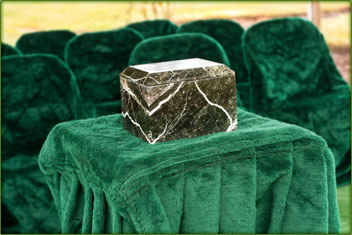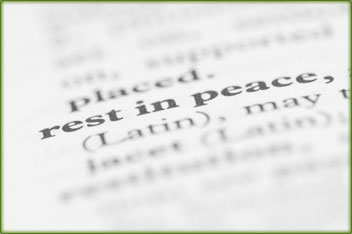Home Funerals
Home funerals, as the name suggests, are funerals that occur in the homes of the deceased instead of funeral homes. This way of organizing a funeral is both more personable and more cost-effective.
Although families are allowed to organize home funerals independently in some states, other states call for the additional involvement of a funeral parlor. Utah, New York, Nebraska, Michigan, Connecticut, Louisiana, or Indiana all involve services of a funeral home, not necessarily throughout the entire process, but at least when obtaining a death certificate, casket transportation, or the release of a body from a hospital. In the aforementioned states, these services must always be rendered by the funeral home.
However, if you live in the 43 remaining states, the funeral can be organized independently and at your own discretion, provided it adheres to the law. Home funerals are actually very similar to other funerals, with the exception of the location. The family will generally perform the home funeral the same way it is traditionally performed by the funeral home.
The loss of a loved one is very often overpowering and can understandably contribute to difficulties in arranging the funeral or memorial service. Since many do not think to plan for their funerals, it can be difficult for family members to make choices for the deceased and end up having to make decisions based on their own preferences or unaware of what the deceased loved one would have wanted.
Planning the funeral of a loved one is always a difficult task. If cost is an issue, cremation and use of the Biodegradable urn is an easy and affordable option.
 If you decide to organize a funeral yourself, be mindful of the local rules in your region. Verify whether your state allows the arrangement of the funeral to be done independently, and become familiar with the legislation and requirements for a funeral. Personally organizing a funeral can be very cost-effective.
If you decide to organize a funeral yourself, be mindful of the local rules in your region. Verify whether your state allows the arrangement of the funeral to be done independently, and become familiar with the legislation and requirements for a funeral. Personally organizing a funeral can be very cost-effective.
The first thing to be done following the death of a loved one is the obtain the death certificate, which is released by the medical examiner. It is relatively easy and inexpensive.
Once the death certificate has been taken care of, the relatives of the deceased can proceed with the type of service they want. They may choose burial or cremation, but what many people don’t realize is that they do not need to bury the deceased in a cemetery. It also buries the loved one on their own plot of land, this avoiding the cost of a burial plot.
Doing your own funeral can entail displaying the body in the living room; this was common in the past as well, before funeral homes were involved in that decision-making. The majority of families used to perform home funerals, and it's still a relevant option today. The family of the deceased uses a funeral notice to inform the community of the death of their loved one. Funeral notices generally take the form of obituaries in the local paper. A typical funeral notice offers the reader a chronological account of the deceased's major life events, listing dates of birth and death. It typically includes a list of living family members. This short biography of the passed loved one is a way of paying tribute to their lives and accomplishments. Most funeral notices conclude with the details of whatever service will be taking place.
 People often read about deaths in the obituaries and consequently attend the funeral. Obituaries are a good way to let many people who may wish to attend know about a death in the family. Recent advances in technology have led to the publishing of obituaries online, which allows people from all over to receive notice of the passing instead of just those in the community. Regular newspapers are going out of style, and online obituaries will most likely be the standard option for funeral notices of the future.
People often read about deaths in the obituaries and consequently attend the funeral. Obituaries are a good way to let many people who may wish to attend know about a death in the family. Recent advances in technology have led to the publishing of obituaries online, which allows people from all over to receive notice of the passing instead of just those in the community. Regular newspapers are going out of style, and online obituaries will most likely be the standard option for funeral notices of the future.
A do-it-yourself funeral is made easier when the burden is shared among relatives and tasks can be delegated outside the nuclear family. A private and intimate service can be both more tasteful and less expensive than one at a funeral home. If you are not expecting too many guests, a home funeral can be a great option.
Environmental concerns and the future of our planet are both very popular concerns in our world today. The market has started to reflect consumer demands for green alternatives in every field possible. As a result, the popularity of green funerals popular until the 20th century is once again on the rise.
Green funerals can take the form of cremations or regular burials. Either is acceptable, provided they use only Eco-friendly materials and minimize the impact on the environment. There are many different guidelines and tools accessible to create green funerals.
Unfortunately, funerals are inevitable parts of all of our lives. When a loved one passes, a funeral arrangement is often far from our minds initially, but it is very important and must be dealt with as soon as possible.
Cremation especially is gaining popularity all across the globe. It is a tasteful and meaningful alternative to the financial burden that comes with other forms of burial.
A body destined for cremation needs to be cleaned of any inorganic material. This includes jewelry, dental work, hip replacements, and pacemakers, which must be removed so as not to jeopardize the cremation process.
After the cremation takes place, the family will be given the ashes. They are placed in a temporary urn made from either plastic or cardboard. If the family plans to scatter the ashes, a permanent urn need not be purchased. Green Burials offers biodegradable Earth and water burial urns, along with scattering tubes, designed to make the scattering of ashes easy. The use of a scattering tube allows multiple persons to scatter the ashes.
